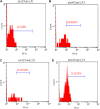The Nephroprotective Effect of Lycopene on Renal Ischemic Reperfusion Injury: A Mouse Model
- PMID: 33013018
- PMCID: PMC7502648
- DOI: 10.1007/s12291-019-00848-7
The Nephroprotective Effect of Lycopene on Renal Ischemic Reperfusion Injury: A Mouse Model
Abstract
Acute kidney injury (AKI) is characterized by fast decline in renal function within a short period of time. Renal ischemic-reperfusion (I-R) injury is the main cause of AKI. This study aims to investigate the possible nephroprotective effect of lycopene on renal ischemic-reperfusion injury in mice model. Forty Swiss Albino adult male mice were randomly allocated onto one of the four study groups: sham group: mice had median laparotomy under anesthesia with no procedures performed, renal tissues and blood samples were collected. ischemic-reperfusion group (I-R-control): mice underwent median laparotomy under anesthesia, followed by 30 min bilateral renal ischemia. Renal tissues and blood samples were collected after 2 h from reperfusion. Vehicle-treated group: mice were pretreated with intra 1% dimethyl sulfoxide 30 min before inducing ischemia. Lycopene-treated group: mice were pretreated with 10 mg/kg intraperitoneal injection of lycopene 30 min before inducing renal ischemia. Renal tissues, and blood samples were collected after 2 h from reperfusion. Blood and tissue samples were collected to look for evidence of inflammation and necrosis. Blood urea nitrogen, serum creatinine as well as plasma NGAL levels were significantly increased in the active control group (P ≤ 0.05), when compared to the sham group. Similarly, renal levels of Notch2/Hes 1, TLR 2, IL-6, Bax, and F2-isoprostane were significantly increased in the active control group as compared to the sham group (P ≤ 0.05). Moreover, lycopene treatment was found to be significantly effective in reducing the increased levels of these markers after I-R injury (P ≤ 0.05).
Keywords: IL-6; Lycopene; NF-κB; Notch2/hes1 protein; Renal ischemia–reperfusion injury.
© Association of Clinical Biochemists of India 2019.
Conflict of interest statement
Conflict of interestThe authors declare that they have no potential conflict of interest.
Figures






Similar articles
-
Notch2/Hes-1 pathway plays an important role in renal ischemia and reperfusion injury-associated inflammation and apoptosis and the γ-secretase inhibitor DAPT has a nephroprotective effect.Ren Fail. 2011;33(2):207-16. doi: 10.3109/0886022X.2011.553979. Ren Fail. 2011. PMID: 21332343
-
Lycopene has reduced renal damage histopathologically and biochemically in experimental renal ischemia-reperfusion injury.Ren Fail. 2015;37(8):1390-5. doi: 10.3109/0886022X.2015.1064742. Epub 2015 Jul 10. Ren Fail. 2015. PMID: 26161692
-
The protective effects of ischemic preconditioning on rats with renal ischemia-reperfusion injury and the effects on the expression of Bcl-2 and Bax.Exp Ther Med. 2017 Nov;14(5):4077-4082. doi: 10.3892/etm.2017.5047. Epub 2017 Aug 28. Exp Ther Med. 2017. PMID: 29067100 Free PMC article.
-
The role of podocyte damage in the etiology of ischemia-reperfusion acute kidney injury and post-injury fibrosis.BMC Nephrol. 2019 Mar 28;20(1):106. doi: 10.1186/s12882-019-1298-x. BMC Nephrol. 2019. PMID: 30922260 Free PMC article.
-
Effects of Lycopene Attenuating Injuries in Ischemia and Reperfusion.Oxid Med Cell Longev. 2022 Oct 7;2022:9309327. doi: 10.1155/2022/9309327. eCollection 2022. Oxid Med Cell Longev. 2022. PMID: 36246396 Free PMC article. Review.
Cited by
-
Potential nephroprotective effects of angiotensin II type 2 receptor agonist Compound 21 in renal ischemia-reperfusion injury.J Med Life. 2023 Sep;16(9):1428-1432. doi: 10.25122/jml-2023-0120. J Med Life. 2023. PMID: 38107718 Free PMC article.
-
Therapeutic effect of lycopene in lipopolysaccharide nephrotoxicity through alleviation of mitochondrial dysfunction, inflammation, and oxidative stress.Mol Biol Rep. 2022 Sep;49(9):8429-8438. doi: 10.1007/s11033-022-07661-1. Epub 2022 Jun 7. Mol Biol Rep. 2022. PMID: 35672542
-
Pharmacological potentials of lycopene against aging and aging-related disorders: A review.Food Sci Nutr. 2023 Jun 27;11(10):5701-5735. doi: 10.1002/fsn3.3523. eCollection 2023 Oct. Food Sci Nutr. 2023. PMID: 37823149 Free PMC article. Review.
-
NETosis and kidney disease: what do we know?Int Urol Nephrol. 2023 Aug;55(8):1985-1994. doi: 10.1007/s11255-023-03527-y. Epub 2023 Feb 25. Int Urol Nephrol. 2023. PMID: 36840801 Review.
-
Semaglutide in renal ischemia-reperfusion injury in mice.J Med Life. 2023 Feb;16(2):317-324. doi: 10.25122/jml-2022-0291. J Med Life. 2023. PMID: 36937464 Free PMC article.
References
LinkOut - more resources
Full Text Sources
Research Materials
Miscellaneous
